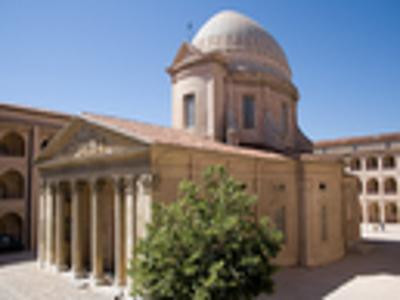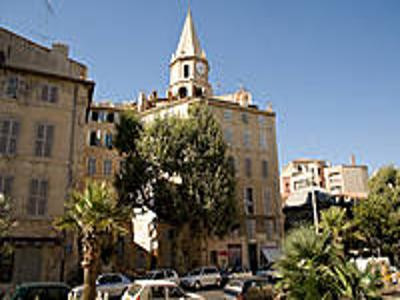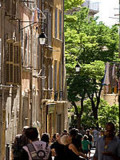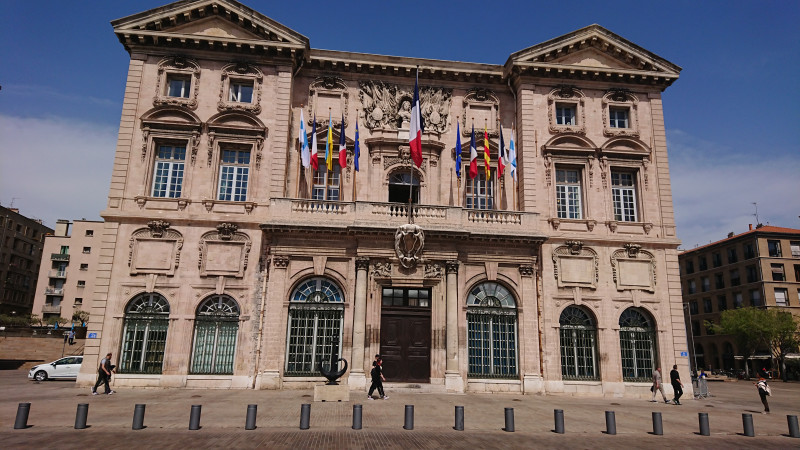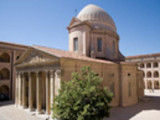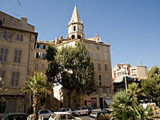The Old Marseille and the Panier
Historic site and monumentPresentation
Behind the Hôtel de Ville, the historical heart of the city called "Le Panier" develops. The origin of the name comes from the sign of an inn "Le Logis du Panier", installed in the 17th century.
Behind of the City Hall, the heart of the city’s old quarter is called “The Panier” (The basket). It’s name apparently derives from the sign of the 17th century inn “Le Logis du Panier” located there.
The Maison Diamantée was built by rich Spanish and Italian trading partners. It was then lived in by well-established Marseille families before it was divided up into apartments during the Revolution. The Maison Diamantée is a perfect example of Provençal mannerism with its unusual façade decorated with raised diamond-shaped tips and the decorated panelled staircase that is unique in Marseille.
At the end of the 19th Century the Maison Diamantée housed port workers and Italian immigrants. At the beginning of the 20th Century it was in a dilapidated state and set to be demolished. In 1922 it was bought by the "Art and Charity" foundation who then made the Committee of Old Marseille its owner. The Maison Diamantée became a National Heritage building in 1925 it was spared from being blown up in 1943 and since 1967 has housed the Musée de Vieux Marseille (Museum of Old Marseille). The museum undertakes to bring to the fore the city's unique qualities and historic traditions using theme-based exhibitions such as the King's galley ships, the 1720 plague, the model of the city centre built by Mr. Lavastre, traditional Marseille costume, interior decoration and furniture, santons and playing cards.
Today, the Maison Diamantée is one of the few remaining souvenirs of the old city that no longer exists, of its aristocratic dwellings in the rich quarter of the city centre that was so dependent on the sea and on commerce.
Pavillon Daviel
The Palais de Justice de Marseille (Marseille Courthouse) was built in the middle of the 18th Century by the Gérard brothers who were Marseille architects. It was built on the site where a 16th Century courthouse had originally stood. The building is built in the pinkish stone from the Couronne quarries and has a façade that is relatively narrow yet perfectly harmonious and that evokes the simple and pleasant architecture of 18th Century Provençal houses. The front section of the building projects slightly outwards and is decorated with an allegorical pediment. The upper floor has a splendid wrought iron balcony comprising panels built in the "marguerite" (daisy) style that was so popular among Marseille craftsmen in the 18th Century. The sculptures of the hand of justice and the torch of Themis, the angels carrying the King's arms (damaged during the Revolution) and children carrying the Tables of the Law and the coat of arms of Marseille are all the work of the sculptor Verdiguier
During the Revolution, sentences were delivered from this balcony, under which stood the guillotine in the square below.
In the Second Empire a new Courthouse was built. From 1875 to 1893 the new building was used by the School of Medicine before it eventually became a Town Hall annexe.(Partially listed as a National Heritage Site in 1945).
The Grand'Rue.
The Grand'Rue follows the ancient road that may still be seen today in the Jardin des Vestiges (Garden of Greek Remains) and that eventually opens into the Place de Lenche, the ancient Greek market place. The original Greek road lies 3 metres under the modern street level. In the 6th Century B.C. it was already a busy street that connected the various public buildings with one another and provided space for markets and local craft and business transactions. It is amusing to realise that in fact very little has changed over 26 Centuries! Various side streets named after guilds led from the Grand'Rue to the port, the centre of the city's commerce.
The Hôtel de Cabre.
The Hôtel de Cabre is on the corner of Rue Bonneterie and the Grand'Rue. This private residence, that was built in 1535 in an unusual mixture of gothic and renaissance styles for the trader and Consul Louis Cabre, is one of the oldest houses in Marseille. When the old quarter was blown up in 1943 the house was saved but later lifted in one piece on jacks and rotated through 90° in order to align it with the present streets to meet with town-planning requirements. The façades have been listed as National Heritage Sites since 1941.
The Hôtel Dieu
The original Saint-Esprit hospital was founded in the 12th Century. It was extended over the centuries and was joined to the Saint-Jacques de Galice hospital in the 16th Century. It eventually became the Hôtel-Dieu a century later. A nephew of the famous architect Hardouin-Mansart then undertook its reconstruction but his ambitious project was only partially completed and the Hôtel-Dieu did not attain its present appearance until the Second Empire. Like all 18th Century hospital buildings it was enclosed on all 4 sides and divided into two main courtyards, one for women and one for men. The architect Blanchet decided to open the southern façade of the hospital to create two wings that end in square pavilions. The three arcades are open to the air and form the walking galleries that are also typical features of hospital architecture of this period. The stairway is the work of Joseph-Esprit Brun and, like that of the Hôtel de Ville, is a fine example of stone vaulting. The handsome wrought iron hand-rail demonstrates the quality of ironmongers' work in Marseille in the 18th Century. The Hôtel Dieu has been included in the Inventory of Additional National Heritage Sites since 1963.
Since Antiquity Marseille has always occupied an important place in medical practice and scientific research. Medicine is still today one of the city's most technologically advanced sectors.
A bronze bust of Jacques Daviel stands in the Hôtel-Dieu forecourt. He was an eye surgeon and practised in Marseille during the 1720 plague. In 1745, while practising at the Hôtel Dieu, he carried out the world's first cataract operation involving removal of the crystalline lens. Three years later he became Louis XV's eye specialist.
Accoules church.
All that has survived of the original church is the bell tower and some remains of the nave. The present church, with its circular architecture, dates from the 19th century. The parish of Accoules is one of the oldest in Marseille.
Le preau des accoules
At the beginning of the 17th Century the Jesuits founded the Eglise de Sainte-Croix (Church of the Holy Cross) and the Collège des quatre langues (School of Four Languages). The school specialised in teaching oriental languages to the young marseillais who were destined to become traders. In 1701 the school became the Royal Observatory in compliance with orders from Louis XIV and also in keeping with the King's wish to develop commerce in Marseille.
The observatory had a series of famous directors including Saint-Jacques de Silvabelle, Pezenas and Pons who discovered the existence of 37 comets and thus set the observatory on a European footing. By 1863 the observatory was considered too small and was moved to the Longchamp Palace gardens. A school has since taken over the old observatory premises while the Preau des Accoules has moved to the great hall of the Academy of Literature, Science and the Arts designed by Joseph-Esprit Brun. This museum is entirely consecrated to children and hosts theme-based cultural activities that are linked to the major exhibitions held in museums throughout Marseille.
Nearby lies the Fonderie Vieille street where originally the Royal foundries were established and later housed various guilds and monastic communities.
When you go down the Montée des Accoules, you may notice that the houses are unusually tall and narrow. This is because people were only allocated a very limited area of land on which to build they therefore had to build upwards. An unusual feature is the fine hand rail that divides the street and that was known as the "conversation" rail, so called because it enabled people to lean on the rail while chatting to the person opposite.
The Place de Lenche.
The Place de Lenche is on the site of the ancient Greek market place, from which the townspeople could keep an eye on events in the port. The square was originally enclosed on all four sides and in the 6th Century Saint Cassien founded the convent of Saint-Sauveur that was built facing the Saint-Victor monastery on the opposite side of the port. In the 8th Century the nuns cut off their noses in order to disgust the Saracen invaders who were intent on raping them. They became known as desnardo (no noses) !. The Saint-Sauveur cellars that lie under the square were, in fact, the water-tanks of the Greek city in the 3rd Century B.C. . They were declared National Heritage Sites in 1840 and are considered to be ancient constructions that have remained in their original condition.
The name "Lenche" comes from that of a Corsican family, Lincio, who left their mark on the square in the 16th Century by establishing a coral-working studio and shops, and by building a sumptuous private residence. In 1553 Thomas Lenche founded the Coral Company to collect coral along the Algerian coastline and in 1561 the Bastion was founded, a company that was used as a base for the company's shipping and trading activities. The Bastion was the origin of the French presence in Algeria and the family became one of the richest in Marseille. They later married into the highest families, even earning the privilege of accommodating Louis XIV during his stay in Marseille in 1660.
Even though the square was not at the centre of the explosions that destroyed the old quarters during the Second World War, the German authorities ordered the South side to be blown up in the winter of 1943. Concrete buildings have since been built on this side of the square.
Streets leading down to the Vieux-Port have been rebuilt to provide view points and the sculptures scattered throughout the quarter are constant reminders of the area's links with the port.
La Vieille Charité.
n 1640 the Town Council decided to "lock up the poor inhabitants of Marseille in a selected clean place", in compliance with the Royal policy of "enclosing the poor".
In 1670 a charity organisation within the Council of Aldermen commissioned Pierre Puget, the King's architect whose childhood was spent in the quarter, to design a Public Hospital intended to accommodate beggars and the poor. The plan was slow in taking shape and the first stone was not laid until 1671. It was to be one of Pierre Puget's most successful architectural achievements but was not, however, completed until 1749.
The building has four wings that are closed to the exterior but comprise a 3 floored-gallery on the inside that overlooks an inner rectangular courtyard. The 3 levels, forming passages between the large work and living areas, correspond to 3 floors inside the building that separated men and women.
The chapel in the centre of the courtyard was built between 1679 and 1707 and it proved to be the most remarkable piece of architecture that Pierre Puget was ever to create for his home town. This chapel with its egg-shaped dome is a perfect example of pure Italian baroque.
The present façade was not built in the 18th Century but dates from 1863. It depicts Charity taking in pauper children this group is flanked by two pelicans feeding their young.
After the Revolution, and until the end of the 19th Century, the Vieille Charité was used as a hospice for old people and children. In 1905 the building was occupied by the army and later became a shelter for the destitute. After the Second World War the architect Le Corbusier was struck by the building and called attention to its abandoned state. It had been scheduled for demolition but finally became a National Heritage building in 1951. The Malraux laws resulted in the beginning of remarkable restoration work on the Vieille Charité in 1968. Since 1986 the building has fulfilled a variety of scientific and cultural functions, housing museums and hosting temporary exhibitions. The Vieille Charité is in the heart of the Panier and is a must for every tourist visiting Marseille.
The Place des Moulins
The location of the Place des Moulins has been known since Antiquity and lies at the highest point in the Panier overlooking the surrounding old town. This upper part of the town was used to defend Marseille against sea and land attacks and it was from here that the canons were fired.
For many years the square was also occupied by windmills whose sails were easily rotated by the wind in this exposed spot. In 1596, fifteen windmills could be seen, giving Marseille its characteristic appearance. However, the use of water to drive machinery gradually took over from the windmills and eventually caused them to close down. In the 19th Century only three windmills were still operating and their stone bases can still be seen today. In the middle of the 19th Century the city authorities ordered the buildings to be demolished in order to create a new square with all the buildings constructed in a more or less identical architectural style. The new Place des Moulins included trees, benches, an area for playing French bowls and, later, a school that gave it a more village-like atmosphere. In 1840 water tanks were built under the square to supply the city with water. A local organisation set up to promote the interests of the Panier is presently studying the possibility of opening a museum based around "The History of Water in Marseille".
Since 1983 the City of Marseille has been working towards rehabilitating the Panier and one of the initial phases of the plan is centred around restoring the friendly atmosphere of the Place des Moulins. The project is already well under way and the results can be seen in the buildings that have been restored, the apartments that have been rebuilt and the streets and squares that have been redesigned.
The Maison Diamantée was built by rich Spanish and Italian trading partners. It was then lived in by well-established Marseille families before it was divided up into apartments during the Revolution. The Maison Diamantée is a perfect example of Provençal mannerism with its unusual façade decorated with raised diamond-shaped tips and the decorated panelled staircase that is unique in Marseille.
At the end of the 19th Century the Maison Diamantée housed port workers and Italian immigrants. At the beginning of the 20th Century it was in a dilapidated state and set to be demolished. In 1922 it was bought by the "Art and Charity" foundation who then made the Committee of Old Marseille its owner. The Maison Diamantée became a National Heritage building in 1925 it was spared from being blown up in 1943 and since 1967 has housed the Musée de Vieux Marseille (Museum of Old Marseille). The museum undertakes to bring to the fore the city's unique qualities and historic traditions using theme-based exhibitions such as the King's galley ships, the 1720 plague, the model of the city centre built by Mr. Lavastre, traditional Marseille costume, interior decoration and furniture, santons and playing cards.
Today, the Maison Diamantée is one of the few remaining souvenirs of the old city that no longer exists, of its aristocratic dwellings in the rich quarter of the city centre that was so dependent on the sea and on commerce.
Pavillon Daviel
The Palais de Justice de Marseille (Marseille Courthouse) was built in the middle of the 18th Century by the Gérard brothers who were Marseille architects. It was built on the site where a 16th Century courthouse had originally stood. The building is built in the pinkish stone from the Couronne quarries and has a façade that is relatively narrow yet perfectly harmonious and that evokes the simple and pleasant architecture of 18th Century Provençal houses. The front section of the building projects slightly outwards and is decorated with an allegorical pediment. The upper floor has a splendid wrought iron balcony comprising panels built in the "marguerite" (daisy) style that was so popular among Marseille craftsmen in the 18th Century. The sculptures of the hand of justice and the torch of Themis, the angels carrying the King's arms (damaged during the Revolution) and children carrying the Tables of the Law and the coat of arms of Marseille are all the work of the sculptor Verdiguier
During the Revolution, sentences were delivered from this balcony, under which stood the guillotine in the square below.
In the Second Empire a new Courthouse was built. From 1875 to 1893 the new building was used by the School of Medicine before it eventually became a Town Hall annexe.(Partially listed as a National Heritage Site in 1945).
The Grand'Rue.
The Grand'Rue follows the ancient road that may still be seen today in the Jardin des Vestiges (Garden of Greek Remains) and that eventually opens into the Place de Lenche, the ancient Greek market place. The original Greek road lies 3 metres under the modern street level. In the 6th Century B.C. it was already a busy street that connected the various public buildings with one another and provided space for markets and local craft and business transactions. It is amusing to realise that in fact very little has changed over 26 Centuries! Various side streets named after guilds led from the Grand'Rue to the port, the centre of the city's commerce.
The Hôtel de Cabre.
The Hôtel de Cabre is on the corner of Rue Bonneterie and the Grand'Rue. This private residence, that was built in 1535 in an unusual mixture of gothic and renaissance styles for the trader and Consul Louis Cabre, is one of the oldest houses in Marseille. When the old quarter was blown up in 1943 the house was saved but later lifted in one piece on jacks and rotated through 90° in order to align it with the present streets to meet with town-planning requirements. The façades have been listed as National Heritage Sites since 1941.
The Hôtel Dieu
The original Saint-Esprit hospital was founded in the 12th Century. It was extended over the centuries and was joined to the Saint-Jacques de Galice hospital in the 16th Century. It eventually became the Hôtel-Dieu a century later. A nephew of the famous architect Hardouin-Mansart then undertook its reconstruction but his ambitious project was only partially completed and the Hôtel-Dieu did not attain its present appearance until the Second Empire. Like all 18th Century hospital buildings it was enclosed on all 4 sides and divided into two main courtyards, one for women and one for men. The architect Blanchet decided to open the southern façade of the hospital to create two wings that end in square pavilions. The three arcades are open to the air and form the walking galleries that are also typical features of hospital architecture of this period. The stairway is the work of Joseph-Esprit Brun and, like that of the Hôtel de Ville, is a fine example of stone vaulting. The handsome wrought iron hand-rail demonstrates the quality of ironmongers' work in Marseille in the 18th Century. The Hôtel Dieu has been included in the Inventory of Additional National Heritage Sites since 1963.
Since Antiquity Marseille has always occupied an important place in medical practice and scientific research. Medicine is still today one of the city's most technologically advanced sectors.
A bronze bust of Jacques Daviel stands in the Hôtel-Dieu forecourt. He was an eye surgeon and practised in Marseille during the 1720 plague. In 1745, while practising at the Hôtel Dieu, he carried out the world's first cataract operation involving removal of the crystalline lens. Three years later he became Louis XV's eye specialist.
Accoules church.
All that has survived of the original church is the bell tower and some remains of the nave. The present church, with its circular architecture, dates from the 19th century. The parish of Accoules is one of the oldest in Marseille.
Le preau des accoules
At the beginning of the 17th Century the Jesuits founded the Eglise de Sainte-Croix (Church of the Holy Cross) and the Collège des quatre langues (School of Four Languages). The school specialised in teaching oriental languages to the young marseillais who were destined to become traders. In 1701 the school became the Royal Observatory in compliance with orders from Louis XIV and also in keeping with the King's wish to develop commerce in Marseille.
The observatory had a series of famous directors including Saint-Jacques de Silvabelle, Pezenas and Pons who discovered the existence of 37 comets and thus set the observatory on a European footing. By 1863 the observatory was considered too small and was moved to the Longchamp Palace gardens. A school has since taken over the old observatory premises while the Preau des Accoules has moved to the great hall of the Academy of Literature, Science and the Arts designed by Joseph-Esprit Brun. This museum is entirely consecrated to children and hosts theme-based cultural activities that are linked to the major exhibitions held in museums throughout Marseille.
Nearby lies the Fonderie Vieille street where originally the Royal foundries were established and later housed various guilds and monastic communities.
When you go down the Montée des Accoules, you may notice that the houses are unusually tall and narrow. This is because people were only allocated a very limited area of land on which to build they therefore had to build upwards. An unusual feature is the fine hand rail that divides the street and that was known as the "conversation" rail, so called because it enabled people to lean on the rail while chatting to the person opposite.
The Place de Lenche.
The Place de Lenche is on the site of the ancient Greek market place, from which the townspeople could keep an eye on events in the port. The square was originally enclosed on all four sides and in the 6th Century Saint Cassien founded the convent of Saint-Sauveur that was built facing the Saint-Victor monastery on the opposite side of the port. In the 8th Century the nuns cut off their noses in order to disgust the Saracen invaders who were intent on raping them. They became known as desnardo (no noses) !. The Saint-Sauveur cellars that lie under the square were, in fact, the water-tanks of the Greek city in the 3rd Century B.C. . They were declared National Heritage Sites in 1840 and are considered to be ancient constructions that have remained in their original condition.
The name "Lenche" comes from that of a Corsican family, Lincio, who left their mark on the square in the 16th Century by establishing a coral-working studio and shops, and by building a sumptuous private residence. In 1553 Thomas Lenche founded the Coral Company to collect coral along the Algerian coastline and in 1561 the Bastion was founded, a company that was used as a base for the company's shipping and trading activities. The Bastion was the origin of the French presence in Algeria and the family became one of the richest in Marseille. They later married into the highest families, even earning the privilege of accommodating Louis XIV during his stay in Marseille in 1660.
Even though the square was not at the centre of the explosions that destroyed the old quarters during the Second World War, the German authorities ordered the South side to be blown up in the winter of 1943. Concrete buildings have since been built on this side of the square.
Streets leading down to the Vieux-Port have been rebuilt to provide view points and the sculptures scattered throughout the quarter are constant reminders of the area's links with the port.
La Vieille Charité.
n 1640 the Town Council decided to "lock up the poor inhabitants of Marseille in a selected clean place", in compliance with the Royal policy of "enclosing the poor".
In 1670 a charity organisation within the Council of Aldermen commissioned Pierre Puget, the King's architect whose childhood was spent in the quarter, to design a Public Hospital intended to accommodate beggars and the poor. The plan was slow in taking shape and the first stone was not laid until 1671. It was to be one of Pierre Puget's most successful architectural achievements but was not, however, completed until 1749.
The building has four wings that are closed to the exterior but comprise a 3 floored-gallery on the inside that overlooks an inner rectangular courtyard. The 3 levels, forming passages between the large work and living areas, correspond to 3 floors inside the building that separated men and women.
The chapel in the centre of the courtyard was built between 1679 and 1707 and it proved to be the most remarkable piece of architecture that Pierre Puget was ever to create for his home town. This chapel with its egg-shaped dome is a perfect example of pure Italian baroque.
The present façade was not built in the 18th Century but dates from 1863. It depicts Charity taking in pauper children this group is flanked by two pelicans feeding their young.
After the Revolution, and until the end of the 19th Century, the Vieille Charité was used as a hospice for old people and children. In 1905 the building was occupied by the army and later became a shelter for the destitute. After the Second World War the architect Le Corbusier was struck by the building and called attention to its abandoned state. It had been scheduled for demolition but finally became a National Heritage building in 1951. The Malraux laws resulted in the beginning of remarkable restoration work on the Vieille Charité in 1968. Since 1986 the building has fulfilled a variety of scientific and cultural functions, housing museums and hosting temporary exhibitions. The Vieille Charité is in the heart of the Panier and is a must for every tourist visiting Marseille.
The Place des Moulins
The location of the Place des Moulins has been known since Antiquity and lies at the highest point in the Panier overlooking the surrounding old town. This upper part of the town was used to defend Marseille against sea and land attacks and it was from here that the canons were fired.
For many years the square was also occupied by windmills whose sails were easily rotated by the wind in this exposed spot. In 1596, fifteen windmills could be seen, giving Marseille its characteristic appearance. However, the use of water to drive machinery gradually took over from the windmills and eventually caused them to close down. In the 19th Century only three windmills were still operating and their stone bases can still be seen today. In the middle of the 19th Century the city authorities ordered the buildings to be demolished in order to create a new square with all the buildings constructed in a more or less identical architectural style. The new Place des Moulins included trees, benches, an area for playing French bowls and, later, a school that gave it a more village-like atmosphere. In 1840 water tanks were built under the square to supply the city with water. A local organisation set up to promote the interests of the Panier is presently studying the possibility of opening a museum based around "The History of Water in Marseille".
Since 1983 the City of Marseille has been working towards rehabilitating the Panier and one of the initial phases of the plan is centred around restoring the friendly atmosphere of the Place des Moulins. The project is already well under way and the results can be seen in the buildings that have been restored, the apartments that have been rebuilt and the streets and squares that have been redesigned.
Opening period (s)From 01/01 to 31/12 daily.
General information
- Park :
- Calanques National Park
Services, Tours, Activities and entertainment
- Historical patrimony :
- Historic patrimony
- Historic district
Contact
The Old Marseille and the Panier
13002
Marseille
Phone : +33 8 10 81 38 13

Destination
Le Vieux Marseille et Le Panier
13002
Marseille
GPS coordinates
Latitude : 43.298233
Longitude : 5.366802



